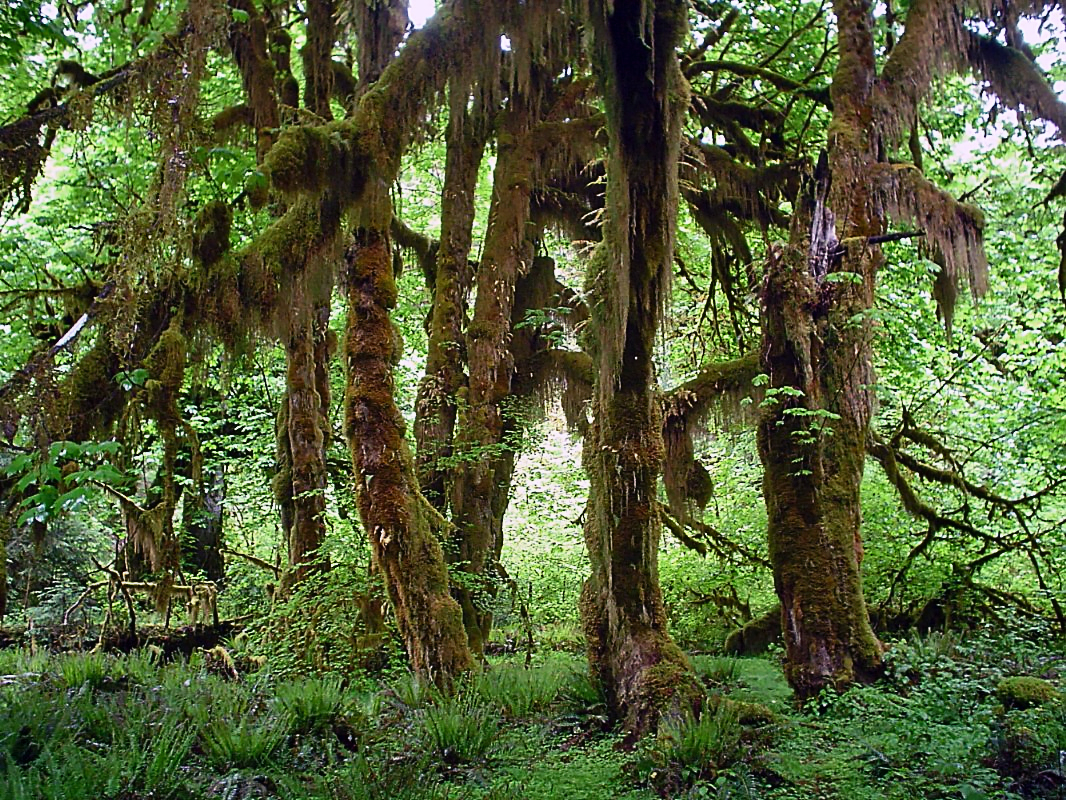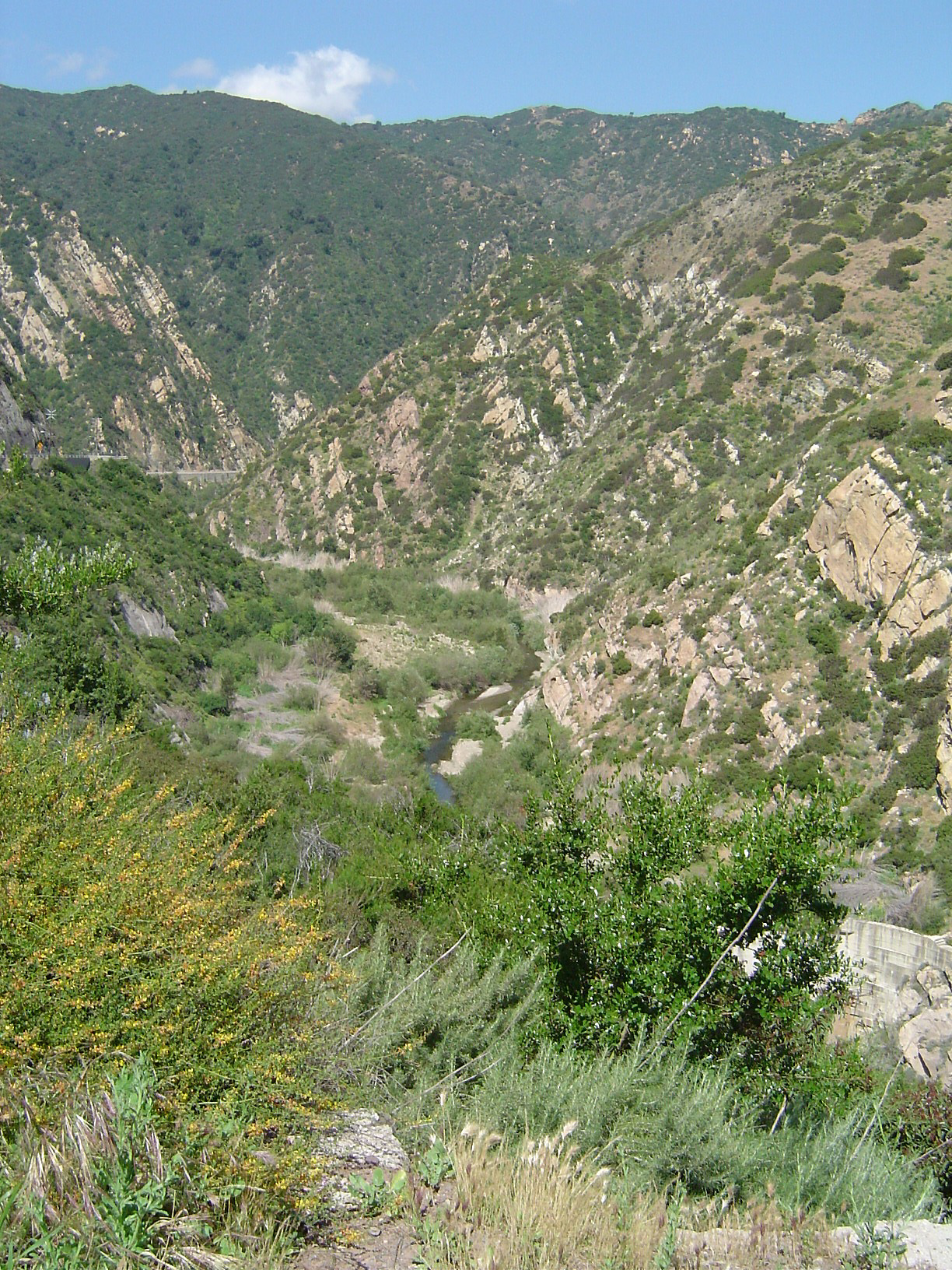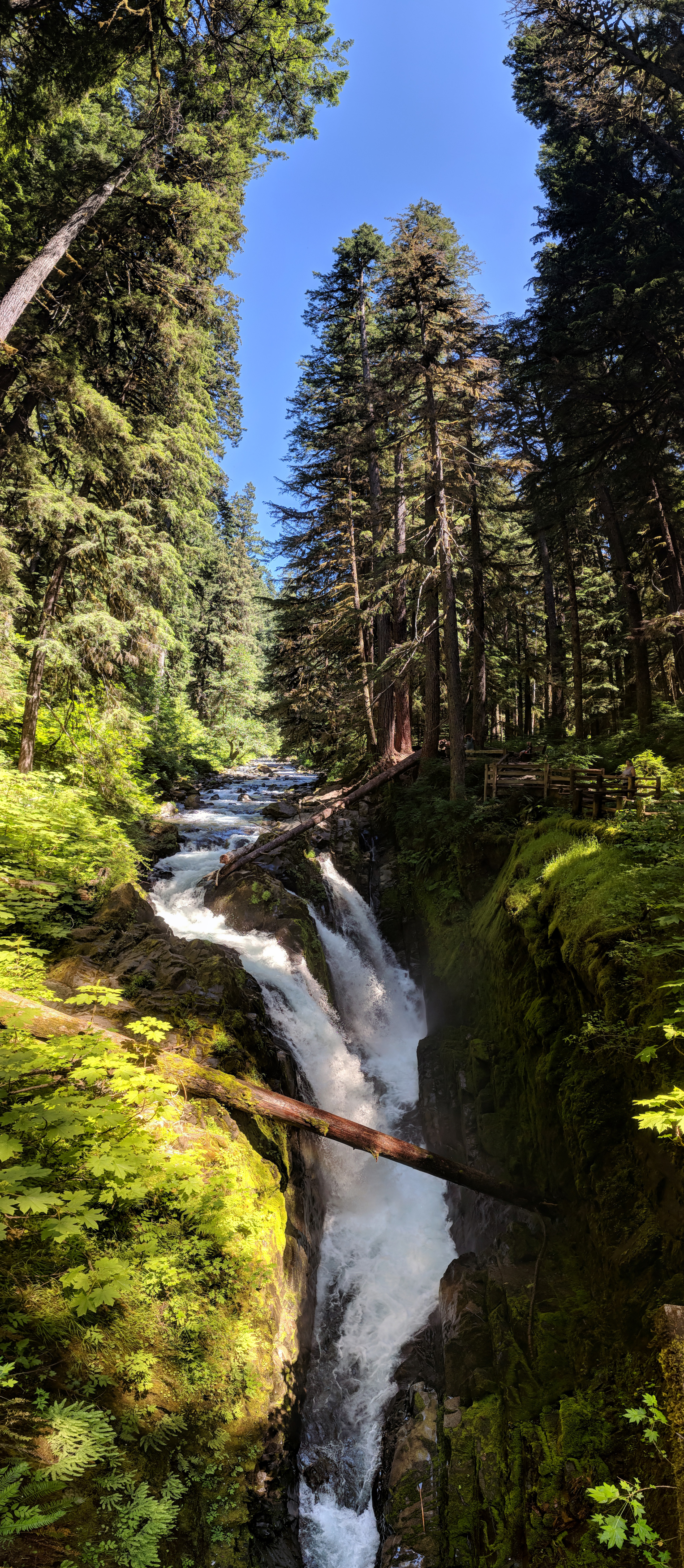|
Olympic Mountains
The Olympic Mountains are a mountain range on the Olympic Peninsula of the Pacific Northwest of the United States. The mountains, part of the Pacific Coast Ranges, are not especially high – Mount Olympus is the highest at ; however, the eastern slopes rise out of Puget Sound from sea level and the western slopes are separated from the Pacific Ocean by the low-lying wide Pacific Ocean coastal plain. The western slopes are the wettest place in the 48 contiguous states. Most of the mountains are protected within the bounds of Olympic National Park and adjoining segments of the Olympic National Forest. The mountains are located in western Washington in the United States, spread out across four counties: Clallam, Grays Harbor, Jefferson and Mason. Physiographically, they are a section of the larger Pacific Border province, which is in turn a part of the larger Pacific Mountain System. Geography The Olympics have the form of a cluster of steep-sided peaks surrounded by heavily ... [...More Info...] [...Related Items...] OR: [Wikipedia] [Google] [Baidu] |
Mount Olympus (Washington)
Mount Olympus, at , is the tallest and most prominent mountain in the Olympic Mountains of western Washington state, US. Located on the Olympic Peninsula, it is also the central feature of Olympic National Park. Mount Olympus is the highest summit of the Olympic Mountains; however, peaks such as Mount Constance and The Brothers, on the eastern margin of the range, are better known, being visible from the Seattle metropolitan area. Description With notable local relief, Mount Olympus ascends over from the elevation confluence of the Hoh River with Glacier Creek in only . Mount Olympus has of prominence, ranking 5th in the state of Washington. Due to heavy winter snowfalls, Mount Olympus supports large glaciers, despite its modest elevation and relatively low latitude. These glaciers include Blue, Hoh, Humes, Jeffers, Hubert, Black Glacier, and White, the longest of which is the Hoh Glacier at . The largest is Blue with a volume of and area of . As with most temperate latit ... [...More Info...] [...Related Items...] OR: [Wikipedia] [Google] [Baidu] |
Pacific Mountain System
The Pacific Coast Ranges (officially gazetted as the Pacific Mountain System in the United States) are the series of mountain ranges that stretch along the West Coast of North America from Alaska south to Northern and Central Mexico. Although they are commonly thought to be the westernmost mountain range of the continental United States and Canada, the geologically distinct Insular Mountains of Vancouver Island lie further west. The Pacific Coast Ranges are part of the North American Cordillera (sometimes known as the Western Cordillera, or in Canada, as the Pacific Cordillera and/or the Canadian Cordillera), which includes the Rocky Mountains, the Columbia Mountains, the Interior Mountains, the Interior Plateau, the Sierra Nevada, the Great Basin mountain ranges, and other ranges and various plateaus and basins. The Pacific Coast Ranges designation, however, only applies to the Western System of the Western Cordillera,S. Holland, ''Landforms of British Columbia'', BC Govt. 1976 ... [...More Info...] [...Related Items...] OR: [Wikipedia] [Google] [Baidu] |
Elwha River
The Elwha River is a river on the Olympic Peninsula in the U.S. state of Washington (state), Washington. From its source at Elwha snowfinger in the Olympic Mountains, it flows generally north to the Strait of Juan de Fuca. Most of the river's course is within the Olympic National Park. The Elwha is one several rivers in the Pacific Northwest that hosts all five species of native Pacific salmon (Chinook salmon, chinook, coho salmon, coho, chum salmon, chum, sockeye salmon, sockeye, and pink salmon), plus four Fish migration, anadromous trout species (Rainbow trout, steelhead, coastal cutthroat trout, bull trout, and Dolly Varden char). From 1911 to 2014, dams blocked fish passage on the lower Elwha River. Before the dams, 400,000 adult salmon returned yearly to spawn in of river habitat. Prior to dam removal, fewer than 4,000 salmon returned each year in only of habitat below the lower dam. The National Park Service removed the two dams as part of the $325 million Elwha Ecosyste ... [...More Info...] [...Related Items...] OR: [Wikipedia] [Google] [Baidu] |
Lyre River
The Lyre River in the U.S. state of Washington flows out of Lake Crescent in the Olympic National Park and into the Strait of Juan de Fuca. Originally referred to as "singing waters" by the indians living near it, the river was first named Rio de Cuesta by Europeans in 1790 by Gonzalo López de Haro, but was later called River Lyre after being charted by Captain Henry Kellett in 1847. Course The Lyre River flows roughly northwest out of Lake Crescent, first encountering June Creek, then turning north at the point that is joined by Boundary Creek on the left. At River Mile 2.7 () the river tumbles down the Lyre River Falls, which are impassable to fish migrating upstream. Continuing north, the river is joined by Susie Creek on the left, and finally Nelson Creek on the right before emptying into the Strait of Juan de Fuca at Low Point. Ecology The first few hundred feet of the river as it flows out of the lake provide spawning habitat for the Beardslee trout (''Oncorhynchus mykiss i ... [...More Info...] [...Related Items...] OR: [Wikipedia] [Google] [Baidu] |
Grays Harbor
Grays Harbor is an estuary, estuarine bay located north of the mouth of the Columbia River, on the southwest Pacific coast of Washington (U.S. state), Washington state, in the United States of America. It is a ria, which formed at the end of the last ice age, when sea levels flooded the Chehalis River (Washington), Chehalis River. The bay is long and wide. The Chehalis River (Washington), Chehalis River flows into its eastern end, where the city of Aberdeen, Washington, Aberdeen stands at that river's mouth, on its north bank, with the somewhat smaller city of Hoquiam, Washington, Hoquiam immediately to its northwest, along the bayshore. Besides the Chehalis, many lesser rivers and streams flow into Grays Harbor, such as Hoquiam River and Humptulips River. A pair of low peninsulas separate it from the Pacific Ocean, except for an opening about two miles (3 km) in width. The northern peninsula, which is largely covered by the community of Ocean Shores, Washington, Ocean Sh ... [...More Info...] [...Related Items...] OR: [Wikipedia] [Google] [Baidu] |
Chehalis River (Washington)
The Chehalis River ( ) is a river in Washington in the United States. It originates in several forks in southwestern Washington, flows east, then north, then west, in a large curve, before emptying into Grays Harbor, an estuary of the Pacific Ocean. It was once much larger during the Ice Age when the tongue of the glacial ice sheet covering the Puget Sound terminated near Olympia and glacial runoff formed a large torrent of meltwater. This carved a large oversized valley that is much larger than the current river could have produced. The river's mouth was out near current Westport until rising sea levels at the end of the ice age flooded the broad Chehalis Valley to form a ria, known today as Grays Harbor. Course The Chehalis River begins at the confluence of the West Fork Chehalis River and East Fork Chehalis River, in southwestern Lewis County. From there the Chehalis flows north and east, collecting tributary streams that drain the Willapa Hills and other low mountains o ... [...More Info...] [...Related Items...] OR: [Wikipedia] [Google] [Baidu] |
Sol Duc River
The Sol Duc River (also spelled Soleduck) is a river in the U.S. state of Washington. About long, it flows west through the northwest part of the Olympic Peninsula, from the Olympic Mountains of Olympic National Park and Olympic National Forest, then through the broad Sol Duc Valley. Near the Pacific Ocean the Sol Duc River joins the Bogachiel River, forming the Quillayute River, which flows about to the Pacific Ocean at La Push. Although the Quillayute River is short, its large tributary rivers—the Sol Duc, Bogachiel, Calawah, and Dickey Rivers—drain the largest watershed of the northern Olympic Peninsula, . The Sol Duc's watershed is the largest of the Quillayute's tributaries, at . The Sol Duc River's main tributaries are its two forks, the North Fork Sol Duc River and the South Fork Sol Duc River. Other notable tributaries include Bear Creek, Beaver Creek, and Lake Creek. Much of the Sol Duc River's watershed is valuable timber land. Most of the forests have b ... [...More Info...] [...Related Items...] OR: [Wikipedia] [Google] [Baidu] |
Bogachiel River
The Bogachiel River () is a river of the Olympic Peninsula in the U.S. state of Washington (state), Washington. It originates near Bogachiel Peak, flows west through the mountains of Olympic National Park. After emerging from the park it joins the Sol Duc River, forming the Quillayute River, which empties into the Pacific Ocean near La Push, Washington. The Quillayute River system, with its main tributaries of the Bogachiel, Sol Duc, Calawah, and Dickey Rivers, drains the largest drainage basin, watershed on the north Olympic Peninsula. The name "Bogachiel" is a corruption of the Quileute language, Quileute words ''bo qwa tcheel el'', or ''/boqʷač'íʔl/'', from ''/bó:q'ʷa/'', "muddy", and ''/číʔlowa/'', "water", meaning "gets riley [turbid] after a rain", "muddy waters", or, less likely, "big river". Course The Bogachiel River begins in several headwater streams near Bogachiel Peak in the Olympic Wilderness of Olympic National Park, in the northwest part of the Olympic P ... [...More Info...] [...Related Items...] OR: [Wikipedia] [Google] [Baidu] |
Hoh River
The Hoh River is a river of the Pacific Northwest, located on the Olympic Peninsula in the U.S. state of Washington. About long, the Hoh River originates at the Hoh Glacier on Mount Olympus and flows west through the Olympic Mountains of Olympic National Park and Olympic National Forest, then through the foothills in a broad valley, emptying into the Pacific Ocean at the Hoh Indian Reservation. The final portion of the Hoh River's course marks the boundary between the coastal segment of Olympic National Park and Olympic National Forest, the Hoh Indian Reservation. The Hoh's drainage basin is . Its discharge, or streamflow, has considerable seasonal variation, with summer streamflow averaging about one-third that of winter flows. The Hoh is a glacial river fed by glaciers on Mount Olympus, such as the Blue Glacier. The glaciers grind rock into a fine glacial flour which turns the Hoh River a milky slate blue color. The river valley is generally broad and relatively flat, caus ... [...More Info...] [...Related Items...] OR: [Wikipedia] [Google] [Baidu] |
Queets River
Queets is an unincorporated community and census-designated place (CDP) in Grays Harbor and Jefferson counties, Washington, United States. The population was 174 at the 2010 census. The primary residents of the community are Native Americans of the Quinault Indian Nation. Geography It is near the coast of the Pacific Ocean along the Queets River at the northern edge of the Quinault Indian Reservation. Queets now consists of several homes, a store, gas station, fisheries, daycare, Head Start, and a remote office for the Quinault Nation. Other local attractions include the Pacific beach hiking trails, Olympic National Park, and Olympic National Forest. U.S. Route 101 passes through Queets, crossing the Queets River at the northern edge of the community. US 101 leads north to Kalaloch Beach and to Forks, site of the nearest airport. Southbound US 101 leads east to Amanda Park and southeast to Aberdeen. According to the United States Census Bureau, the Queets CDP has a total ... [...More Info...] [...Related Items...] OR: [Wikipedia] [Google] [Baidu] |
Quinault River
Quinault may refer to: * Quinault people, an Indigenous people of the Pacific Northwest Coast **Quinault Indian Nation, a federally recognized tribe **Quinault language, their language People * Quinault family of actors, including * Jean-Baptiste-Maurice Quinault (1687–1745), comedian and musician ** Jeanne Quinault (1699–1783), actor, bluestocking ''saloniste'' ** Philippe Quinault a French dramatist and librettist (1635–1688) ** Marie-Anne-Catherine Quinault (1695–1791), French singer and composer Places * Quinault Canyon * Lake Quinault * Quinault River, a river located on the Olympic Peninsula in the U.S. state of Washington * Quinault Pass * Quinault Rainforest * Quinault, Washington Other * Quinault Treaty The Quinault Treaty (also known as the Quinault River Treaty and the Treaty of Olympia) was a treaty agreement between the United States and the Native American Quinault and Quileute tribes located in the western Olympic Peninsula north of Grays ..., signed ... [...More Info...] [...Related Items...] OR: [Wikipedia] [Google] [Baidu] |
Humptulips River
The Humptulips River is a river in Grays Harbor County, Washington, in the United States. Its main tributaries are the East Fork Humptulips River, about long (32 km), and West Fork Humptulips River, about long (48 km). After the forks join, the main river is approximately 20 miles (32 km) long. The Humptulips has a drainage basin of . The river's average discharge is , with a maximum recorded discharge of , in November, 2006, and a minimum of , in September, 1944. Variant names, according to the United States Geological Survey (USGS), include Hum-tu-lups, Humptolups, Humtutup, and Um-ta-lah. The name comes from the Humptulips Indians, part of the Chehalis tribe. Some sources say the word "humptulips" means "hard to pole" while others say it means "chilly region". Course The Humptulips River originates in the Olympic National Forest in the East Fork and West Fork. This region of Olympic Peninsula receives around of precipitation annually, feeding many streams. ... [...More Info...] [...Related Items...] OR: [Wikipedia] [Google] [Baidu] |




